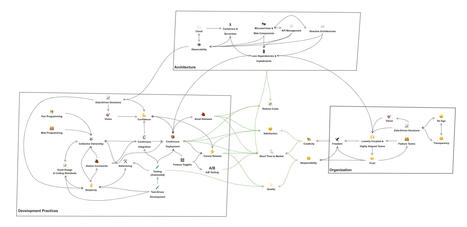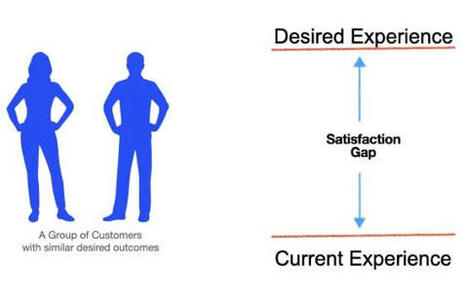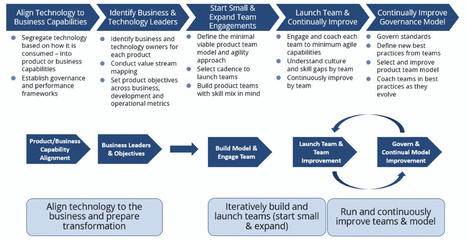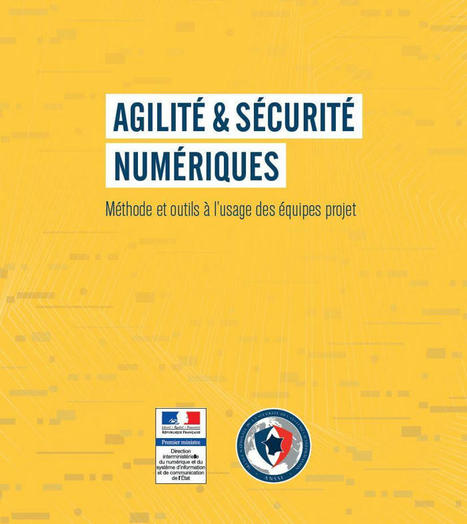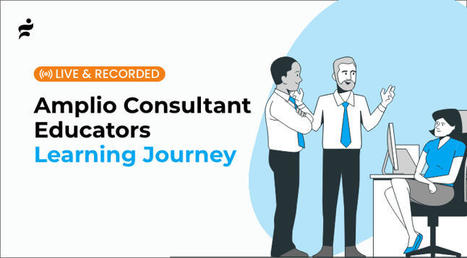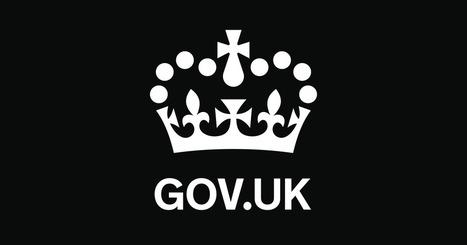Bien au-delà d’un simple exercice de surveillance et de conservation, il s’agit assurément de mettre à jour nos compétences, notre savoir et nos relations aux autres. A vous maintenant de découvrir le large éventail de méthodes et d’approches présentées par Constantin Guay pour faire sa veille, et les nombreux avantages que vous pourrez en tirer.
Get Started for FREE
Sign up with Facebook Sign up with X
I don't have a Facebook or a X account

 Your new post is loading... Your new post is loading...
 Your new post is loading... Your new post is loading...
Current selected tags: 'Agile', 'coaching agile'. Clear
Un schéma qui explique les relations entre les pratiques techniques et l'agilité.
From
hbr
Scrums and kanbans can’t help you if you’ve got a legacy culture that punishes vulnerability.
Via Oliver Durrer swissleap.com
Too often, agile remains confined to software development. But companies that successfully implement agile across their entire enterprise can create an exceptional customer experience and gain an edge over the competition.
Mickael Ruau's insight:
Companies that rely on overly specialized roles create meaningful inefficiencies that can damage the customer experience. (See Exhibit 1.) Customers forced to endure delays owing to multiple handoffs or rework will soon take their business elsewhere. Yet many large companies find restructuring difficult because their organizations are bogged down by a large and highly customized product catalog, disparate IT systems, or poorly integrated M&A activity—all of which bolster the need for specialized resources. While displacing deeply entrenched processes and practices can be difficult, companies that successfully incorporate agile beyond software see transformative results.
This came up within another “little conversation” that I had with Jim McCarthy at the OSA (Open Space Agility) FB group, the other day. Yes, the the author of the Core Protocols, and a guy that has the uncanny ability to make me more blunt, as if I needed any help.
Les clients cherchent des solutions qui améliorent leurs résultats. Mais pour y parvenir, les organisations doivent d'abord livrer quelque chose, mesurer les résultats et s’adapter en fonction. L’agilité organisationnelle permet de le faire de manière répétée, fréquente et avec le plus petit investissement possible pour un plus grand nombre de rétroactions.
Mickael Ruau's insight:
Points Clés
Beaucoup d’encre a déjà coulé sur les atouts commerciaux d’une organisation agile. Devenir agile n’est pas seulement une question technologique. Pour obtenir les progrès escomptés en efficacité et en innovation, les entreprises doivent se poser les questions suivantes: quel chemin allons-nous prendre ? Qui devra être impliqué ? L’approche agile apportera-t-elle les bénéfices quantitatifs et qualitatifs que nous recherchons ?
L’ANSSI est l'autorité nationale en matière de sécurité et de défense des systèmes d’information. Prévention, protection, réaction, formation et labellisation de solutions et de services pour la sécurité numérique de la Nation.
Mickael Ruau's insight:
The picture shows the connections of agility in projects: It clearly shows that agility is more than just methods. This is where the term agility 4.0 originated. Because a project or company is only agile if all seven points and their networking are taken into account.
Les Valeurs et Principes sont rigoureusement identiques à la version officielle du Manifeste. Leur numérotation respecte l’ordre du Manifeste.
Mickael Ruau's insight:
Manifeste pour le développement Agile de logiciels
Crystal method is an agile software development approach that focuses primarily on people and their interactions when working on a project rather than on processes and tools. Alistair believed that people’s skills and talents as well as the way they communicate has the biggest impact on the outcome of the project. Crystal Method is based on two fundamental assumptions:
According to Cockburn, we should view product development as a game that should stimulate everyone to interact, become creative, and produce brilliant ideas. He says that instead of focusing on questions like “is our model accurate?” we should be looking for answers to questions like “Is our product meeting the customer’s needs? Or “Do we have our goals aligned as a team?”
Mickael Ruau's insight:
Crystal method family membersOne of the things that Cockburn discovered is that the project properties changed depending on the number of people involved in the project and the level of criticality of the project at hand. While the smaller team can handle and build the product without a lot of status reporting and paperwork, the number of “communication artifacts” rises with bigger teams who are working on large-scale projects. In other words, the more people you have on the team, the more critical the project is and the more complex the approach needs to be. Therefore, there is no one single Crystal method; there are different Crystal methodologies for different types of projects. To make this categorization easy to understand, Cockburn named the methodology Crystal and categorized it along the two dimensions - size and criticality - that matching those of minerals - color and hardness. Essentially, Cockburn developed these families to point out that each project may require a particular set of policies, practices, and processes in order to meet the project’s unique characteristics. Cockburn tried to explain this by calling Crystal “a set of samples that you adjust to your circumstances”. Which approach will be most suitable for your projects depends on three dimensions:
Generally, they are characterized by colors, according to the number of people involved in the project:
 Agile modeling - WikipediaAgile modeling (AM) is a methodology for modeling and documenting software systems based on best practices. It is a collection of values and principles, that can be applied on an (agile) software development project. This methodology is more flexible than traditional modeling methods, making it a better fit in a fast changing environment.
Mickael Ruau's insight:
What is InnerSource?
We define InnerSource as: The use of open source principles and practices for software development within the confines of an organization. InnerSource takes the lessons learned from developing open source software and applies them to the way companies develop software internally. As developers have become accustomed to working on world-class open source software, there is a strong desire to bring those practices back inside the firewall and apply them to software that companies may be reluctant to release. For companies building mostly closed source software, InnerSource can be a great tool to help break down silos, encourage and scale internal collaboration, accelerate new engineer on-boarding, and identify opportunities to contribute software back to the open source world. What are InnerSource Patterns? Patterns are a way of describing a repeatable, proven solution to a problem within a context. Patterns follow a simple form that assists you during the implementation of a solution to understand the constraints of the problem, understand the forces you need to balance, and the resulting context - the situation created by applying the solution. Patterns can provide a way for the InnerSource Commons participants to concisely share information, improving the practice of InnerSource. Patterns are divided into Title, Problem Statement, Context, Forces, and Solutions as their main sections.
|
Essential concepts mostly missing in popular frameworks
L'agilité ne se fait pas toute seule, il faut l'instaurer avec soin et attention. Un regard sur les différentes façons d'implémenter l'agilité et les pièges à …
To increase their agility, chief marketing officers require very different capabilities and structures than were needed in the past.
Mickael Ruau's insight:
Centralize the Right Activities. Many companies are seeking to centralize functions so that they can put in place better controls and create greater efficiencies. But they often are not strategic enough about what they centralize. In our study, we found that many companies are leaving savings on the table by not centralizing thoughtfully: they are missing out on creating economies of scale and are unable to take full advantage of best practices. (See Exhibit 2.)
Our brain sees cause-effect relationships where there are none and does not notice problems where there are some. We try to explain the inexplicable, are interested in details and hierarchies. Therefore, when “everything is difficult,” you must look for flexible approaches - and here Agile comes to the rescue.
Let's define the software development life cycle, make an overview of the 7 most used models, and find out their differences and benefits in projec
Mickael Ruau's insight:
The DevOps model has its unique principles that promote automation and team collaboration. Therefore, the primary focus of the model is the enhancement of collaboration between teams that are driven by sequential feedback. The DevOps model resembles the Agile methodology, but differs due to the collaboration focus between technical team members and managers, while Agile focuses on client involvement. What does DevOps carry out?
 Déclaration d'interdépendance - WikipédiaLa déclaration d'interdépendance est un ensemble de six principes de gestion, initialement prévu pour le développement logiciel agile, et applicable à d'autres situations de gestion.
Mickael Ruau's insight:
OriginesAprès le Manifeste pour le développement agile de logiciels, écrit en 2001, David Anderson, Sanjiv Augustin, Christopher Avery, Alistair Cockburn, Mike Cohn, Doug DeCarlo, Donna Fitzgerald, Jim Highsmith, Ole Jepsen, Lowell Lindstrom, Todd Peu, Kent McDonald, Pollyanna Pixton, Preston Smith et Robert Wysocki ont observé que les principes agiles pourraient être applicables pour atteindre un état d'esprit « agile » de gestion de projets y compris en dehors de l'informatique. En 2005, ils ont publié la « Déclaration d'interdépendance »1,2 sont : PrincipesLa déclaration est un ensemble de six principes qui mettent en évidence les approches en matière de leadership plus applicable aux méthodes de travail agiles. Chacun des principes de la déclaration est structuré comme une combinaison de deux clauses : le premier alinéa déclare un résultat souhaité, tandis que le second montre comment atteindre ce résultat2,3 :
Notes et références
(en) « Site de la PMDOI » [archive]
On entend régulièrement parler de culture agile, d’esprit agile et on peut raisonnablement se demander ce que l’on met dans ces concepts. Je vous propose de partir de sa définition opérationnelle initiale pour aller à jusqu’à la vision de ce qu’est une culture agile et de ce qu’elle implique pour l’organisation qui souhaite s’en imprégner.
Mickael Ruau's insight:
Agilité organisationnellePetit à petit le développement des équipes agiles et leur méthodes de management ont eu des répercussions sur l’ensemble de l’organisation. L’agilité se répand pas pollinisation ou essaimage et contamine les autres entités de l’organisation. Au niveau organisationnel, on retrouve des valeurs opérationnelles traduites à l’échelle de l’organisation et qui favorisent le développement de la culture agile au sein de celle-ci. Dans ses valeurs, on retrouve la notion de transparence portée par les pratiques au travers du management visuel et au travers de la qualité des relations des acteurs de l’agilité, client compris. Ceci se retrouve également au travers d’une production orientée autour de la création de valeur où chaque acteur connait la valeur de ses contributions et sait pour quoi il œuvre. Les entreprises agiles vivent la transparence comme une nécessité pour permettre la montée en autonomie. On retrouve également la notion de sens donné à l’action, les équipes agiles fonctionnent en ayant connaissance de l’ensemble des objectifs projets pour lesquels ils œuvrent et partagent les enjeux clients, de faits, la culture de la responsabilité passe par le fait de savoir inscrire ce que l’on fait dans quelques chose de plus grand. Les entreprises qui portent l’agilité au plus haut dans leur structure ont parfaitement compris cela. Développer l’esprit de contribution et de confiance est un autre point sur lequel l’agilité organisationnelle s’appuie. La culture de l’auto-organisation et de l’initiative doit être portée au plus haut niveau pour se répandre et se renforcer. Chaque personne doit pouvoir se sentir acteur plein et entier de son organisation et ses organisations en laissant ces équipes se développer sans ingérence y contribuent.
Table des matières :
Mickael Ruau's insight:
Au milieu de l'année 2009, j'ai créé Bonitasoft avec deux autres cofondateurs, Miguel Valdés Faura et Rodrigue Le Gall, et nous avons commencé le développement de notre logiciel avec 7 développeurs. C'est en janvier 2010 que nous avons lancé Bonita Open Solution 5.0, la première version du logiciel éditée par notre société. Aujourd'hui, nous sommes les leaders des logiciels BPM Open Source avec plus de 2,75 millions de téléchargements, plus de 875 clients et une communauté de plus de 60 000 contributeurs. Bonitasoft compte actuellement 17 développeurs travaillant à temps complet sur la solution Bonita BPM, ainsi qu'un architecte système, une équipe QA (assurance/qualité), une équipe dédiée à la documentation et un ingénieur ergonome, soit une équipe de 40 personnes. Comment fait-on croître une équipe de développement de plus de 200% en moins de 5 ans tout en maintenant sa position de leader ? Cela s'est avéré un réel défi et une expérience enrichissante, mais surtout une opportunité d'appliquer des méthodes agiles avancées et efficaces.
I first heard of the Stacey Matrix when taking my Agile Scrum Product Owner certification course. It was heralded as a means to determine when to use Agile and when to use traditional Waterfall software development methodologies.
Mickael Ruau's insight:
Here's how I remember the diagram: The problem with this diagram is that there is no difference between "What" and "How". To me this is just hype that says "Agile is better". The message is: the more complicated a project, the more you need Agile. The message defeated the purpose of having a 2x2 matrix, it made it into a one-dimension line, from lower-left to upper-right. There was no difference between the horizontal or vertical dimensions. It positioned Waterfall in the lower left corner and Agile in the upper right. The message was that unless you have a simple project (lower left), you need Agile. Really? Do you think you could get Waterfall proponents to agree to that? The same folks who develop little programs like operating systems and database engines? Again, I'm an Agile proponent, but I am faced with a challenge of addressing the morale of software developers with a long history of successful Waterfall projects. Developers in general are typically smart folks. Repeating any kind of hype or religion would only remove me from their list of trusted sources. There was no explanation So after the course I did a little research and was not surprised to find that Ralph D Stacey himself had no intention of using his Matrix to make this decision. On the Ralph Stacey Wikipedia page it says that Stacey "dropped the diagram and now argues against it's use". As much as I like Agile I can't explain why the methodology appears to have such a need to sell itself and to inflate the importance of it's origins. Well as long as everyone else is mis-using the Matrix I may as well join in. I figure once you put a concept out there you can't take it back. From my experience I propose that Waterfall methodology does have a place, and it is in the upper left quadrant of the Matrix (this is where you have agreement on what, but now how). The lower right quadrant is better for Agile methodology (where you have agreement on how, but not what). The upper right quadrant (chaos) is just as bad for both methodologies, and the lower left quadrant (simplicity) is equally good for both. Why? There is a big difference between knowing what you want to build and knowing how to build it.
Skills a service team needs to deliver a successful user-focused service.
Mickael Ruau's insight:
Your service team must include people doing a variety of different roles (this type of team is called a multidisciplinary team). You may need to include other roles depending on the size of your service. Roles your team must haveA team building a government service needs to have people with the following roles or skills either in the team or available to it:
The skills you need will change throughout the lifecycle of your service. Read more about the roles you’ll need at each service phase. Your whole team, and in particular your designers, user researchers, content designers and developers, must work together to design, build and iterate a service based on the user needs of the people your service is aimed at.
Pour ceux qui sont dans les grands groupes, vous allez être étonné de découvrir cette méthodologie FDD car on y trouve beaucoup de choses qui se mettent en place dans ces grands groupes… Et ce sont mêmes des choses dites « non agile ». En fait le FDD est ancien et il est vrai que l’agilité a en réalité évolué avec le temps. Cependant, on la considère comme l’une des méthodes agiles existantes malgré ses contradictions avec des méthodes agiles telles que XP ou Scrum. Le FDD (Feature-driven development) propose :
Mickael Ruau's insight:
Les itérations du FDD en 5 étapesUne itération en FDD (Feature-driven development) se compose en 5 étapes différentes :
Contrairement au Scrum et à l’Extrême programming, le FDD recommande fortement d’assigner les fonctionnalités à un ou des développeurs précis. Les 6 rôles clés en FDD (Feature-driven development)La méthodologie FDD définit 6 rôles clés dont certains peu appréciés par la communauté agile d’aujourd’hui.
Increase productivity of your team within the agile framework. How agile is helping us to build a high-performance team? What are the principles we can use to build my team? |





